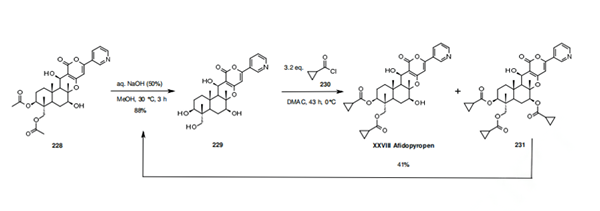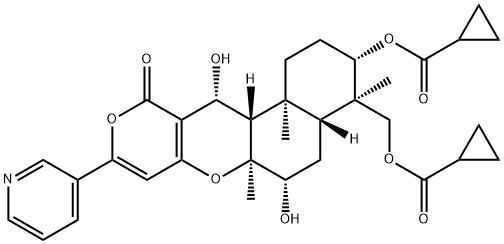Afidopyropen: Synthesis and Introduction
Synthesis of Afidopyropen
The semi-synthesis of afidopyropen (XXVIII) and is based on a process patent application published by BASF. The semi-synthesis begins from the natural product pyripyropne A 228, which is hydrolysed under basic condition to afford 229. The free hydroxyl groups of 229 are then acylated with cyclopropane carbonyl chloride (230). Some selectivity is observed and afidopyropen (XXVIII) can be obtained in 41% yield, together with the tri-acylated product (231). The latter can be easily recycled to 229.

Introduction of Afidopyropen
Afidopyropen is a new, natural product derived insecticide with an unknown mode of action. It is reported to be active against sucking insects, such as pea aphids (acyrthosiphon pisum). The molecule is based on the natural product pyripyropne A (228) that was isolated by the group of Ōmura from the fungi Aspergillus fumigatus. In their original articles, Ōmura et al. already reported that pyripyropene A is active on the acyl-coenzyme A cholesterol acyltransferase (ACAT) with an IC50 value of 58 nM. The group of Gloer subsequently reported not only on the isolation of pyripyropene A (228) from the fungi Eupenicilium crustaceum, but also on its insecticidal properties. A collaboration between the Ōmura group and Meiji Seika Pharma also confirmed pyripyropene A 228 to be a potent insecticide, which was the starting point for the discovery of afidopyropen. The molecule XXVIII is now under development through collaboration between Japan’s Meiji Seika Pharma and BASF.157 The Insecticide Resistance Action Committee (IRAC) proposed selective homopteran feeding blockers as a mode of action. This is the group encompassing pymetrozine 226 and flonicamid 227 (Figure 12). Apart from a common 3-substituted pyridine ring, the three molecules do not appear to be closely related. In a recent paper, Scott et al. concluded it is possible that pymetrozine (226) and afidopyropen indeed share the same mode of action as both have identical insecticidal spectrum and have similar symptomology on crayfish.



